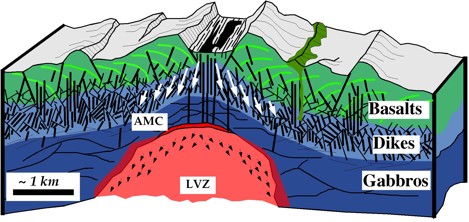Karson
Toward a Comprehensive View of Seafloor Spreading: Integrating R2K Surface Data with Subsurface Geological Perspectives
J.A. Karson¹*, D.L. Siler¹, A.J. Horst¹, R.G. Varga² & D. Curewitz¹
Corresponding author: jakarson@syr.edu
¹Syracuse University, Department of Earth Sciences, Syracuse, NY 13244-1070
²Whitman College, Department of Geology, Walla Walla, WA
Abstract:
The R2K program has provided a wealth of data from the actively spreading systems in the ISS areas. These include direct observational information from the surface and indirect geophysical data. Investigations from deep crustal drilling, tectonic windows into the upper oceanic crust, ophiolites, and deeply eroded parts of Iceland provide perspectives on subsurface processes in analogous spreading systems. These studies reveal geological relationships and by inference, processes that are unlikely to be resolved from R2K surface or indirect studies alone because: 1) surface features generally do not uniquely constrain subsurface processes, and 2) important geological features develop on time-scales that are much longer than those of ridge axial studies.
An important example is the role of subaxial subsidence in the construction and modification of the oceanic crust. R2K studies show systems dominated by lava flows fed by dike intrusion events focused along a narrow (<1 km) axial depression with very limited relief. However, subsurface structures reveal that axial lavas must subside hundreds of meters immediately beneath the axis as the overlying lava pile thickens. In order for this to occur without the build-up of substantial surface relief, dramatic, focused subaxial subsidence must occur. This subsidence is linked to pervasive brittle damage and block rotations in the upper crust and mass redistribution in the axial magma chamber and underlying low-velocity zone. Subsidence must dominate over lateral spreading at the axis where these processes would be masked by surficial lava flows. Furthermore, subsidence, magmatic construction, and hydrothermal processes very along-axis. Near spreading segment centers subsidence and crustal thickening are greatest. Magma supply and tectonic movements have a very strong vertical component. Near segment ends, subsidence is limited and horizontal dike injection dominates. These processes have profound implications for the structure of the oceanic crust, the interpretation of seismic structure, heat loss and permeable pathways for hydrothermal systems, habitats for the deep biosphere, and other themes directly relevant to R2K.
Contributions to Integration and Synthesis:
In order to move toward a comprehensive view of seafloor spreading at intermediate to fast rates, subsurface geology and processes must be integrated into the R2K perspective. As synthesis of the R2K data sets moves forward, it would be useful to consider how available subsurface geological data might relate to the surface geology and geophysical data. What next-generation studies could be designed to link these perspectives?
Figures:
Figure 1. Schematic diagram of subsurface processes at intermediate to fast-spreading ridges based on results of deep crustal drilling, tectonic windows, ophiolites and spreading analogs. Subhorizontal surficial lavas mask a complex subsurface structure that implies important spreading processes that may not be evident from the surface. Basaltic lavas thicken rapidly at the axis without building substantial relief. Thickening is accommodated by subsidence (white arrows) of highly fractured upper crust (lower lavas, dikes and probably upper gabbroic rocks). Vertical magmatic flow in the AMC and LVZ must also be important. The resulting crustal architecture includes inward-dipping lava flows (time lines in light green), outward-dipping and cross-cutting dikes (bold lines) in a pervasively fractured upper crust. The petrology and flow kinematics of the AMC and LVZ remain poorly constrained. Karson_fig1.jpg

